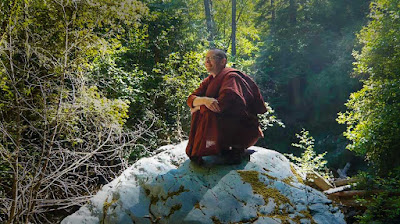Maurice O'Connell Walshe (trans.) from Samyutta Nikaya: An Anthology (Wheel 318-321), Kaccayanagotto Sutra (SN 12.15) edited by Dhr. Seven and Crystal Quintero, Wisdom Quarterly
 |
| Lay meditator and monastic under the bodhi tree, India (Ghosh/Tapasphotography/flickr). |
.
[SAVATTHI, ancient India - Ven. Kaccayana asked the Buddha:] "'Right view,* right view,' it is said, venerable sir. In what way is there right view?'
- [*Right view, the first step of the Noble Eightfold Path, literally means "right seeing." "Right understanding" is misleading because the connotations are too intellectual rendering it "right views" (plural) is misleading because this is not a matter of holding "views" (opinions) at all but rather of "seeing things as they really are."]
"Kaccayana, the world in general inclines toward two views, existence or non-existence.
- [Existence: being (atthita, lit. "is-ness") is the theory of "Eternalism" (sassatavada). Nonexistence: nonbeing (natthita, "is-not-ness)" is the theory of "Annihilationism" (ucchedavaada), the materialism view. See discussion in Bhikkhu Bodhi's translation of DN 1, The All-Embracing Net of Views (BPS), pp. 30-33.]
 |
| Bhikkhu Bodhi (bps.lk) |
"But for one who, with the highest wisdom, sees the arising/origination of the world as it really is [yathabhutam], 'non-existence of the world' does not apply. And for one who, with highest wisdom, sees the passing away of the world as it really is, 'existence of the world' does not apply.
"Kaccayana, the world in general grasps after systems and is imprisoned by dogmas ["ideologies" or "isms"].
"But one [who sees with the highest wisdom] does not go along with that system-grasping, that mental obstinacy, and dogmatic bias, does not grasp at it, does not affirm: 'This is my self.'
- [This is my self: Atta me ti:] Cf. SN 3.8, n. 1. Feer's edition of SN reads here atta na me ti "this is not myself," which would also make sense but is contradicted, not only in SA (Commentary), but also when the story is repeated at SN 22.90.]
 |
| Fully-ordained Buddhist nun on meditation rock in California forest (bhikkhuni.net) |
.
"One knows without any doubt or hesitation that whatever arises/originates is merely dukkha [inherent unsatisfactoriness of personality-phenomena and general insecurity of all conditioned existence] that what passes away is merely dukkha, and such knowledge is one's own, not depending on anyone else. This, Kaccayana, is what constitutes right view.- [Compare this to the point of the Heart Sutra, which states that the "perfection" of wisdom is comprehending the Five Aggregates (form, feeling, perception, mental formations, and consciousness) as empty, i.e., as void of self.]
"'Everything exists,' this is one extreme [view].
- [Everything exists (sabbam atthi) -- from the Sanskrit form, sarvam asti (used in a slightly different sense) -- is where the defunct Sarvastivada school got its name. They held that dharmas exist in "three times" (past, present, future). It was mainly to this early school that the label "Hinayana" ("Lesser Career or Vehicle") was applied and later misapplied to today's Theravada school (see SN 12.22, n. 1).]
"'Nothing exists,' this is the other extreme. Avoiding both extremes the Tathagata teaches a doctrine of the middle:
- [Tathagata is the Buddha's usual way of referring to himself: literally "Thus Come" tatha-agata or "Thus Gone (beyond)" (tatha-gata). For other meanings, see Bhikkhu Bodhi, The All-Embracing Net of Views (BPS), pp. 50-53, 331-344.10.]
 |
| The Buddha remembered in gold (smep-muc). |
"But as a result of the complete fading away and cessation of ignorance there comes the cessation of the formations; as a result of the cessation of the formations comes the cessation of consciousness [the same for all 12 links of Dependent Origination]...
"So there comes about the complete cessation of this entire mass of suffering." [The cessation of all suffering = nirvana.]
"So there comes about the complete cessation of this entire mass of suffering." [The cessation of all suffering = nirvana.]

















































































































































































































































No comments:
Post a Comment